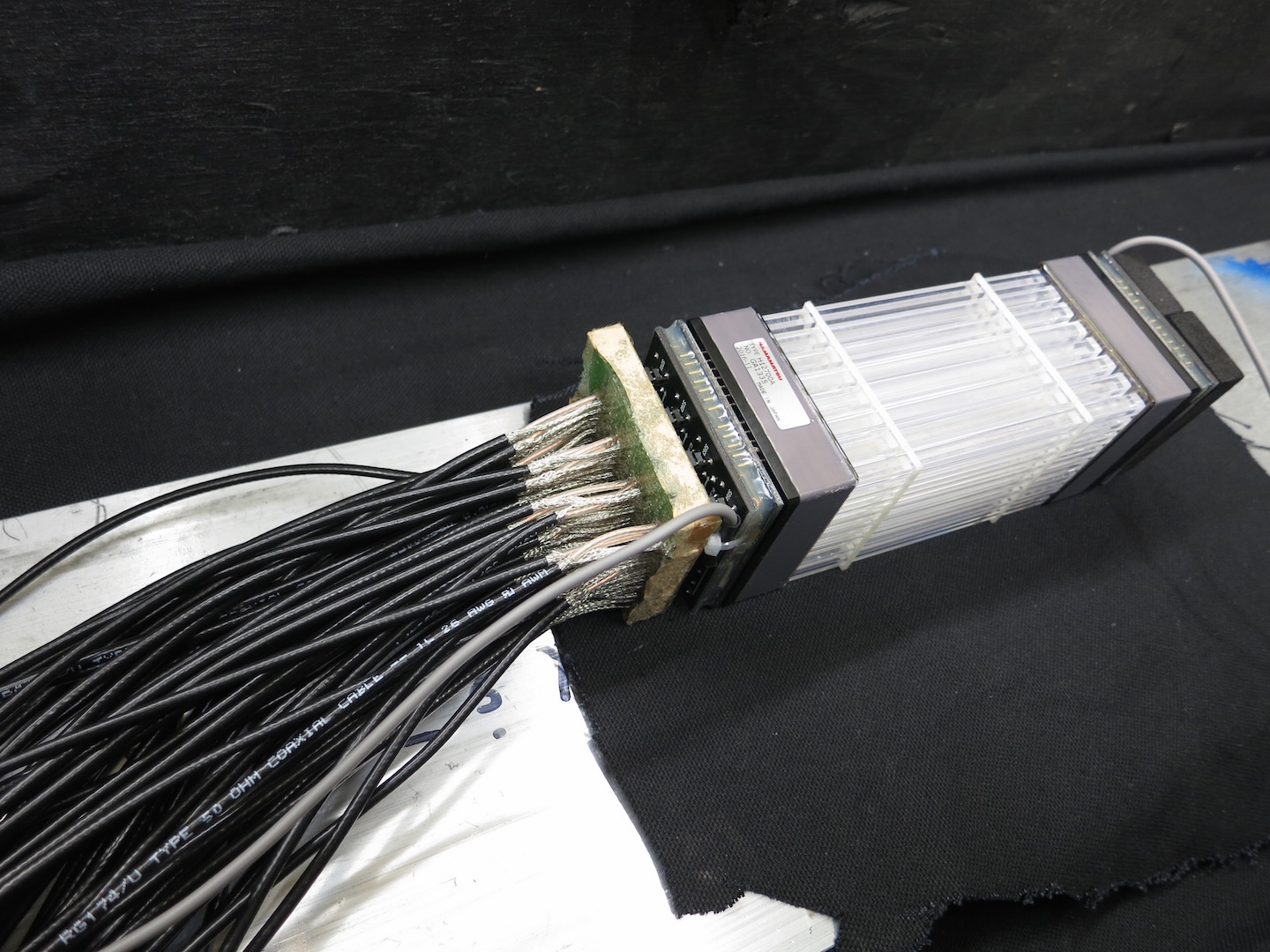Steven Dazeley (17-ERD-016)
Executive Summary
We are developing novel technologies that will increase the sensitivity of nuclear reactor antineutrino detectors, deployable aboveground with reduced shielding requirements. We expect to produce, for the first time, a detection technique that is sensitive to the direction of a reactor antineutrino flux, which supports DOE/NNSA and Lawrence Livermore National Laboratory's mission in nonproliferation, and is relevant to newly proposed neutrino experiments that will test the Standard Model of particle physics.
Project Description
Nuclear reactors are copious emitters of a type of neutrino called the electron antineutrino, which has not only become an important target of fundamental physics research, but also provides a direct window into the fission processes in the reactor core, making it an important tool for nonproliferation. Lawrence Livermore has pioneered antineutrino-based reactor monitoring for nonproliferation. Recent experiments by our group and others have shown that the fissile content of a reactor core can be estimated from the rate and energy spectrum of antineutrinos emitted by the fission process. The antineutrino’s importance to basic physics research is demonstrated by the question of the existence of the proposed sterile neutrino, now a major focus of study of reactor neutrino physics. The existence of at least one variety of sterile neutrino would imply physics beyond the Standard Model of particle interactions, and offers a possible explanation for the reactor neutrino anomaly and the unexplained excess of neutrinos observed from low-energy neutrino beams at other ongoing neutrino observatories. The ability to measure the direction of antineutrino emissions, discriminating them from background emissions, could help resolve questions in both basic physics and nonproliferation. We will build and deploy a novel reactor antineutrino detector sensitive to the direction of an incoming antineutrino flux. The activity is based on fine-grained segmentation of a new form of pulse-shape-sensitive plastic scintillator developed at Lawrence Livermore, which can be doped with the neutron-capturing agent lithium-6, and is sensitive to differences in gamma-ray and neutron-induced interactions via the shape of the detected light signal. Within the field of antineutrino detection, recent projects have only just incorporated pulse-shape-sensitive liquid for particle identification. However, these new detectors lack the position resolution necessary to reconstruct the direction of the flux. Fine-grained segmentation, made feasible for the first time by the plastic form, provides the necessary position resolution to make it a reality. If successful, the project will enable a new technology, deployable aboveground with reduced shielding requirements.
We expect to develop novel technologies that increase the sensitivity of reactor antineutrino detectors. A successful project will result in (1) a smoothing and polishing apparatus; (2) a test stand for measuring attenuation length in a rod or fiber; (3) a set of polished rods of the pulse-shape-sensitive plastic scintillator with similar attenuation-length performance; (4) an understanding of the performance of the prototype detector, including particle identification sensitivity based on rod multiplicity; and (5) construction and aboveground deployment of an antineutrino detector at a reactor. We expect to produce, for the first time, a detection technique sensitive to the direction of a reactor antineutrino flux. Reactor antineutrino detectors are typically surrounded by large volumes of hydrogenous shielding and deployed belowground to shield them from the effects of cosmogenic-sourced fast-neutron background. If successful, directional sensitivity will help to identify false antineutrinos caused by fast neutrons. This capability could enable aboveground deployments with less shielding requirements. Beyond antineutrino detection, detector capabilities required for directionality, high-resolution position, and particle-range sensitivities, have potential applications in fast-neutron detection for nonproliferation. Our technique also has particular relevance for newly proposed neutrino experiments that will test the Standard Model of particle physics. Spinoff technologies such as improved particle identification and position resolution are also likely to improve neutron detection in high-rate environments, also of interest for nonproliferation applications.
Mission Relevance
This research supports DOE/NNSA and Lawrence Livermore's goals to reduce the threat from weapons of mass destruction by providing new detection capabilities for reactor antineutrino monitoring and advances the Laboratory’s core competency in nuclear, chemical, and isotopic science and technology.
FY17 Accomplishments and Results
In FY17 we began four parallel efforts. Specifically, we (1) produced pulse-shape-discriminating plastic scintillator samples doped with lithium-6—these 17.78-cm-long samples are the longest ever produced, and tests indicate sufficient light emission for our purposes; (2) produced a polishing table for multiple rods per batch, and identified process improvements for a new table we are building that can polish longer rods faster; (3) updated a data acquisition code for handling more channels, which we are using to test our early scintillator samples; and (4) produced a Geant4-based detector simulation code, which awaits tuning data from a real detector (Geant4 is a toolkit for the simulation of the passage of particles through matter).
Publications and Presentations
Dazeley, S. 2017. "Antineutrino Detection Based on 6Li‐doped Pulse Shape Sensitive Plastic Scintillator." Presentation at Lawrence Livermore National Laboratory, Livermore, CA. LLNL-PRES-732979.
Dazeley, S., et al. 2017. "Antineutrino Detection Based on 6Li-doped Pulse Shape Sensitive Plastic Scintillator and Gadolinium-doped Water." Antineutrino Detection Based on 6Li-doped Pulse Shape Sensitive Plastic Scintillator, Rethynmo, Crete, Greece, 11–17 June 2017. LLNL-PROC-735100.
———. 2017. "Directional Sensitivity to Reactor Antineutrinos with Pulse Shape Discriminating (PSD) Plastic Scintillator." Presentation at Lawrence Livermore National Laboratory, Livermore, CA. LLNL-POST-740620.
   





